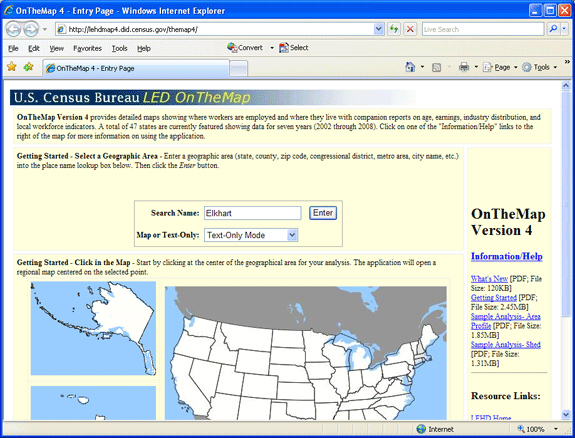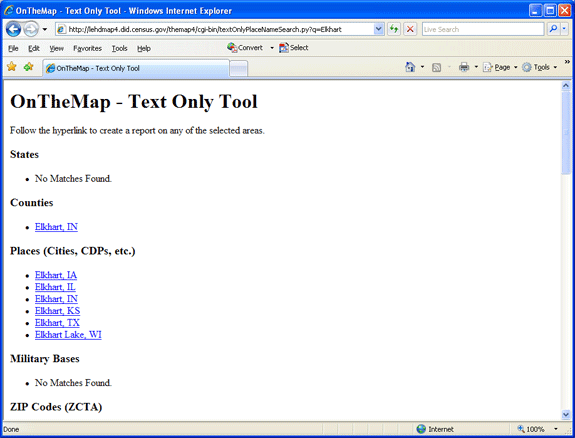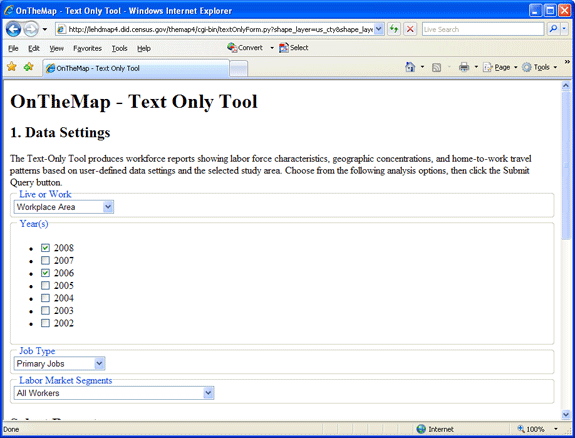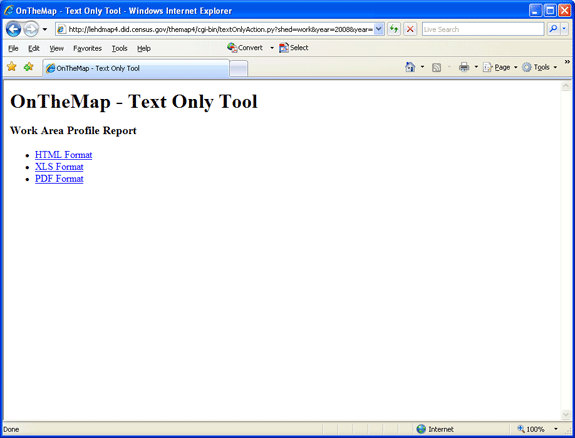Where Can I Find Commuting Data?
Understanding the relationship between where people live and where people work is necessary for a variety of analyses. Commuting data at the county-level is readily available from a variety of sources, but this article will focus on how you can use the Local Employment Dynamics (LED) data from the Census Bureau to better understand commuting flows for smaller units of geography, such as cities, ZIP codes or school districts.
The Census Bureau recently released OnTheMap. This tool provides data about where workers are employed and where they live with companion reports on age, earnings, industry distribution and local workforce indicators. Data are available for 47 states with coverage from 2002 through 2008.1
The map interface itself is somewhat cumbersome, so this article walks you through how to actually bypass the maps and access the data tables more quickly. (However, for those who are interested in using the map interface, several tutorials are available on the site.) For purposes of this article, we will look at where people who work in the city of Elkhart live.
The Steps
Step 1: Search for a Geographic Area
From the start page, type in your geography in the “Search Name” field. Note: Don’t try to be helpful and enter the type of the geography or other limiting factors (such as “Elkhart City” or “Elkhart, IN”). Doing so will cause no matches to be found. Change the “Map or Text-Only” field to text-only mode. Then select “Enter.”

Step 2: Choose Geography of Interest
The resulting page provides a list of all the geographies in the database that match what you typed. Select the specific geography of interest.

Step 3: Customize Your Data Settings
This is where all of the important data settings occur, so we’ll provide some explanation as to the available choices.
- Live or Work: Since we’re interested in where Elkhart’s workers live, we will select “Workplace Area.” However, if we were instead interested in where the people who live in Elkhart work, we would change this to “Home/Residential Area.”
- Year: Select as many years as you are interested in studying and each will show up as a column in the resulting report. Note: especially where the travel sheds are concerned, choosing several years will slow the performance of the site.
- Job Type: Options include all jobs, primary jobs (a primary job is the highest paying job for an individual worker for the year), all private jobs (all jobs in the private sector) or private primary (all primary jobs in the private sector).
- Labor Market Segments: Analysis can be limited to the defined age groups, to those with earnings between a certain range or to those working in a given industry class.
- Report Type: The Home/Work Area Profile would provide the demographic characteristics of workers in Elkhart. However, since we are interested in commuting patterns, we will select the Home/Work Shed Analysis.
- Rollups: When the home/work shed analysis is selected, you will also want to designate rollup areas. This means that if you select ZIP codes as a rollup, you will see the top 10 ZIP codes that sent workers into the city of Elkhart, whereas if you selected county subdivisions (aka townships), you would see the top 10 townships where Elkhart workers lived. For this example, we selected places, counties and ZIP codes. Note: you must limit your analysis to three rollup areas in order to avoid receiving a server error.

Step 4: Download Report
Once you submit the query, output is available in three formats: webpage (HTML), spreadsheet (XLS) or PDF depending on what suits your purposes.

The Results
Table 1 shows the output for our query, which looked at all jobs for all workers in the city of Elkhart. We see that 21 percent of Elkhart workers lived within the city and 55 percent lived within the county. The most commuters from the city level came from South Bend and Mishawaka. (Remember however that since we are looking at all jobs vs. just primary jobs, people who hold more than one job are being counted more than once).
Table 1: Where Workers Live Who Are Employed in the City of Elkhart
| 2008 | 2006 | |||
| Count | Share | Count | Share | |
| Total All Jobs | 39,282 | 100.0% | 40,974 | 100.0% |
| By Place | ||||
| Elkhart city, IN | 8,224 | 20.9% | 9,976 | 24.3% |
| South Bend city, IN | 2,338 | 6.0% | 2,143 | 5.2% |
| Mishawaka city, IN | 1,887 | 4.8% | 1,772 | 4.3% |
| Goshen city, IN | 1,571 | 4.0% | 1,723 | 4.2% |
| Granger CDP, IN | 1,056 | 2.7% | 1,137 | 2.8% |
| Dunlap CDP, IN | 861 | 2.2% | 996 | 2.4% |
| Simonton Lake CDP, IN | 782 | 2.0% | 940 | 2.3% |
| Indianapolis city (balance), IN | 378 | 1.0% | 317 | 0.8% |
| Fort Wayne city, IN | 301 | 0.8% | 373 | 0.9% |
| Nappanee city, IN | 268 | 0.7% | 211 | 0.5% |
| All Other Locations | 21,616 | 55.0% | 21,386 | 52.2% |
| By County | ||||
| Elkhart County, IN | 21,514 | 54.8% | 24,687 | 60.3% |
| St. Joseph County, IN | 7,619 | 19.4% | 7,252 | 17.7% |
| Cass County, MI | 2,451 | 6.2% | 2,295 | 5.6% |
| Kosciusko County, IN | 665 | 1.7% | 523 | 1.3% |
| St. Joseph County, MI | 616 | 1.6% | 516 | 1.3% |
| Berrien County, MI | 586 | 1.5% | 566 | 1.4% |
| Marshall County, IN | 482 | 1.2% | 384 | 0.9% |
| Marion County, IN | 414 | 1.1% | 348 | 0.8% |
| Allen County, IN | 403 | 1.0% | 501 | 1.2% |
| Noble County, IN | 332 | 0.8% | 365 | 0.9% |
| All Other Locations | 4,200 | 10.7% | 3,537 | 8.6% |
| By ZIP Code | ||||
| 46514 | 7,168 | 18.2% | 8,383 | 20.5% |
| 46516 | 5,126 | 13.0% | 6,336 | 15.5% |
| 46517 | 3,117 | 7.9% | 3,608 | 8.8% |
| 46528 | 1,767 | 4.5% | 1,767 | 4.3% |
| 46526 | 1,413 | 3.6% | 1,517 | 3.7% |
| 46544 | 1,305 | 3.3% | 1,208 | 2.9% |
| 46507 | 1,210 | 3.1% | 1,399 | 3.4% |
| 46530 | 1,176 | 3.0% | 1,267 | 3.1% |
| 46561 | 1,054 | 2.7% | 1,132 | 2.8% |
| 46545 | 1,015 | 2.6% | 1,023 | 2.5% |
| All Other Locations | 14,931 | 38.0% | 13,334 | 32.5% |
Source: U.S. Census Bureau, LED OnTheMap Origin-Destination Database
While OnTheMap does only provide you with detail on the top 10 geographies in each rollup area, this tool is still quite useful for those desiring to analyze commuting patterns at the community level.
Notes
- Because LED is a voluntary partnership between state labor market agencies and the Census Bureau, a few states (Connecticut, Massachusetts, New Hampshire, plus the District of Columbia) are not participants.
Rachel Justis
Geodemographic Analyst, Indiana Business Research Center, Indiana University's Kelley School of Business
